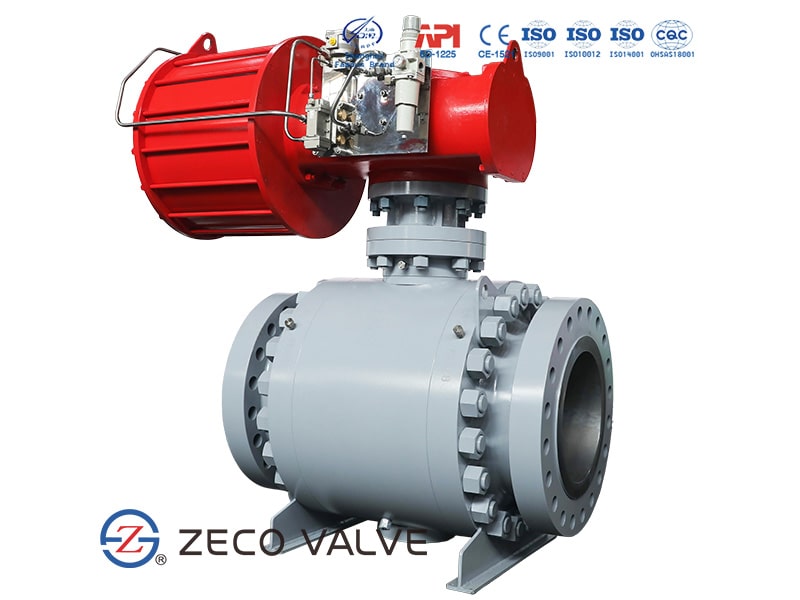HOTLINE: +840902720814

ZECO pneumatic ball valve is composed of pneumatic actuator and ball valve named. The advantage of pneumatic ball valve is the fast switching speed, the normal switching speed can reach 0.05 seconds/time, also because of the fast switching, ZECO pneumatic ball valve is often used as a quick cut-off valve on the pipeline. Pneumatic devices are often equipped with solenoid valves, air source processing triplets, limit switch, positioner, and control box, so ZECO pneumatic ball valve and electric ball valve can also achieve remote operation.
Pneumatic actuators control ball valves by the conversion of compressed air energy to mechanical motion. A rotary mechanical motion is required in a ball valve for a 90 degrees turn. Pneumatic actuator ball valves can be single-acting or double-acting. A single-acting pneumatic actuator uses a single compressed air input to turn the valve and a spring to return the valve to the normal position. A double-acting pneumatic actuator has two compressed air inputs to turn the valve and return the valve to its original position.
The most common mechanism for a pneumatic actuator for ball valves is the rack and pinion mechanism. This comprises the rack (a linear gear) and the pinion (a circular gear). The rack is attached to a piston which is pushed by compressed air to achieve linear motion. This linear motion is converted to circular motion by the pinion. The pinion drives the stem of a ball valve to open and close positions.
To control the pneumatic actuator for ball valves, the compressed air is regulated by solenoid valves. Electrical signals from the controller energize the solenoid valve to either open or close positions allowing compressed air to flow through to both piston sides of the pneumatic actuator. The piston pushes the rack which turns the pinion connected to the stem of the ball valve.
Pneumatic ball valves are suitable for use across numerous industries that use fluids like water, gas, air, oil, and other media. When you buy actuated ball valves, you can use them for any of the following applications:
| No | Part | Material |
| 1 | Body | FORGED STEEL / CARBON STEEL / STAINLESS STEEL |
| 2 | Bonnet | FORGED STEEL / CARBON STEEL / STAINLESS STEEL |
| 3 | Ball | FORGED STEEL / STAINLESS STEEL |
| 4 | Seat | PEFE / DEVELON / PEEK / METAL |
| 5 | Stem | FORGED STEEL / STAINLESS STEEL |
| 6 | Anti-static Device | SS304 / SS316 |
| 7 | Gasket | Graphite + SS304 / SS316 |
| 8 | Bolt | ASTM A193 B7 / B8 / B8M |
| 9 | Nut | ASTM A194 2H / 8 / 8M |
| 10 | O-ring | Viton A |
| 11 | Pneumatic Actuator | SS304 / SS316 / Aluminium |
Double-acting cylinder generally with two-position five-way solenoid valve or three-position five-way solenoid valve. The single-acting cylinder can be equipped with a two-position three-way solenoid valve. The voltage can be DC24V, AC220V, etc. Explosion-proof requirements should be considered.
The role of the actuator is to convert the rotation of the contact signal, and output to the control instrumentation, and feedback on the opening and closing state of the ball valve. Commonly used are mechanical and magnetic induction types. Explosion-proof requirements should also be considered.
There are two and three parts, the function filtering, decompression, and oil mist. It is recommended to install them to avoid cylinder jamming due to impurities in the cylinder.
The three pneumatic accessories mentioned above are usually fitted as standard, the following are additional options.
For proportional adjustment pneumatic ball valves need to be installed, mostly used for pneumatic V-shaped ball valves. Input 4-20mA, to consider whether with the feedback output signal. Whether explosion-proof is required. There are ordinary types and intelligent types.
Installed between the ball valve and the cylinder, can be changed to a manual switch in case of gas source failure, to ensure system safety and not delay production.
It can speed up the opening and closing of pneumatic ball valves. Installed between the cylinder and the solenoid valve so that the gas in the cylinder does not pass through the solenoid valve and is quickly discharged.
It is installed in the air path to the cylinder to receive the pressure signal from the positioner outlet, providing a large flow rate to the actuator, used to increase the speed of valve action. By 1:1 (ratio of signal to output). Mainly used to transmit pneumatic signals to long distances (0-300m) and to reduce the effects of transmission lag.
Mainly for the interlocking operation of the air source pressure, cutting off the valve air supply line when it is lower than the air source pressure so that the valve maintains the position before the air source failure. When the air source pressure is restored, the air supply to the cylinder is restored at the same time.

Nhập email của bạn để nhận thông báo sớm nhất của chúng tôi
